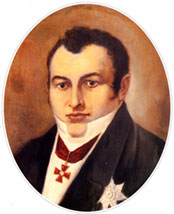 |
| Pavel Schilling |
Baron Pavel L’vovitch Schilling made significant contributions in the field of electrical telegraphy in the early twentieth century and was in fact the pioneer in inventing electromagnetic telegraphy.
Pavel Schilling was born as Paul Constadt, Baron von Schilling in Reval, in present Estonia in 1786. He worked as a diplomat at the Russian embassy in Munich, Germany. It was here that he witnessed electricity for the first time and derived his inspiration for working with electricity. He developed a way to detonate explosives using electric wires from a distance. In 1813-14, Schilling returned home to Russia to fight against Napoleon’s invading army. Afterwards he went to Paris and expanded his knowledge on electric mines, cables and telegraphy. He also learned about Oersted’s discovery of electromagnetism and spent the next several years working on a practical telegraph system using electromagnetism. He was also influenced by Sturgeon, Ampere and Schweigger.
In 1828, Schilling launched his first prototype telegraph using electric current transferred along the wires stretched between two locations. In 1832, he made a short distance transmission of electric signals between two telegraphs in two different rooms of his apartment. He was the first to put into practice a binary system of signal transmission. Schilling demonstrated his telegraph model to the Tsar in St. Petersburg. In 1835, he demonstrated at the congress of scientists in Bonn. In 1836, the British government tried to buy Schilling’s design but he offered it to Russia. His model was tested on a 5 kilometers experimental ground with also some underwater cables laid around the building of the Admiralty in St. Petersburg and was approved for a telegraph between the imperial palace at Peterhof and the naval base at Kronstadt. However, Schilling died in 1837 and this telegraph line was not built in the end.
Though Schilling’s electromagnetic telegraph line was not actually built, it provided an influential model for future telegraphs and inspired others like William Cooke.
Source: http://ethw.org/Pavel_Schilling
The mid-19th century was a pioneering time in world technology: iron-clad ships were invented, as were steam engines, new farming techniques were introduced, and new chemicals were discovered, also during this time telegraphy was invented. Telegraphy has revolutionised communication around the world, both on a local, national and international scale. No longer do people have to wait days for a horseman to deliver messages from A to B (assuming that it did indeed arrive and wasn't stolen by a highwayman on the road or a pirate on the seas). Instead they can have their message delivered instantly and at minimal cost. These benefits are not a new development, they didn't come around with the invention of the mobile phone, they came around in the 1850's thanks to men like Pavel Schelling who revolutionised international communication.
[End.]
No comments:
Post a Comment